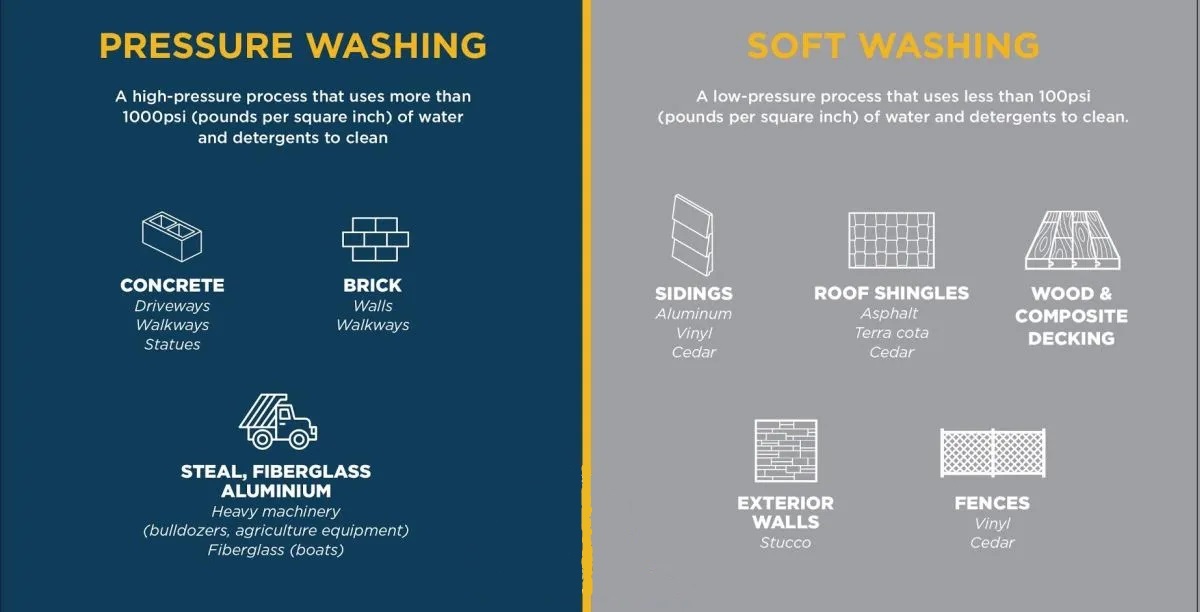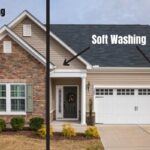Soft washing and pressure cleaning are two distinct methods used for cleaning various surfaces. Each method has its advantages and is suitable for specific cleaning tasks. Here’s a breakdown of the key differences between soft washing and pressure cleaning:
Definitions of Soft Washing and Pressure Washing
Soft washing is a specialized cleaning method that employs low-pressure water and environmentally friendly cleaning solutions to remove stubborn stains, mold, algae, and grime from delicate surfaces. This technique is ideal for South African homes adorned with intricate woodwork, fragile stucco, and painted exteriors..
Pressure washing utilizes high-pressure water to clean robust surfaces such as driveways, walkways, brick walls, and concrete patios. This method is perfect for South African properties that require a powerful cleaning solution to combat deeply embedded dirt and stains.
Differences Between Soft Washing and Pressure Washing
Water Pressure:
- Soft Washing: Soft washing uses low-pressure water, typically around 100 psi (pounds per square inch) or even lower. The primary cleaning agent in soft washing is specially formulated chemicals and detergents that break down dirt, grime, mold, and other contaminants. The low-pressure spray ensures that delicate surfaces aren’t damaged during the cleaning process.
- Pressure Cleaning: Pressure cleaning, also known as pressure washing, employs high-pressure water, ranging from 1,500 psi to 3,000 psi or even higher, depending on the equipment used. The forceful stream of water is effective in removing stubborn stains, mold, algae, grease, and dirt from durable surfaces like concrete, brick, metal, and stone.
Cleaning Solutions:
- Soft Washing: Soft washing relies heavily on specialized cleaning solutions. These solutions often contain biodegradable chemicals, bleach, soaps, and surfactants that not only clean the surface but also kill mold, algae, and mildew at their roots. The cleaning solution does most of the work in soft washing, making it gentle on delicate materials.
- Pressure Cleaning: Pressure cleaning primarily uses the mechanical force of high-pressure water to remove contaminants. While some pressure cleaning tasks may involve mild detergents, the emphasis is on the power of the water stream to clean surfaces effectively.
Suitable Surfaces:
- Soft Washing: Soft washing is ideal for delicate surfaces such as roofs, stucco, wood, vinyl sidings, painted surfaces, and more. It’s particularly useful for removing organic growth like mold and algae without damaging the underlying material.
- Pressure Cleaning: Pressure cleaning is best suited for robust surfaces like driveways, sidewalks, concrete walls, decks, and metal structures. It is excellent for removing tough stains, grime, oil, and graffiti from these durable surfaces.
Versatility:
- Soft Washing: Soft washing is specialized and designed for specific cleaning tasks, especially those involving sensitive surfaces. It’s not as versatile as pressure cleaning in terms of the range of surfaces it can effectively clean.
- Pressure Cleaning: Pressure cleaning is versatile and can be used for a wide variety of cleaning tasks. It is the preferred method for cleaning large outdoor areas and tough stains.
In summary, soft washing is a gentle and specialized method that relies on low-pressure water and cleaning solutions to clean delicate surfaces, while pressure cleaning utilizes high-pressure water to clean durable and stubborn stains on a wide range of surfaces. Choosing between soft washing and pressure cleaning depends on the specific cleaning requirements and the type of surface you need to clean.
Difference in Application

Here’s a breakdown of which cleaning method is suitable for specific surfaces and cleaning tasks:
Soft Washing:
1. Roofs: Soft washing is ideal for cleaning roofs, especially those made of delicate materials such as asphalt shingles, wood, or tiles. It effectively removes mold, algae, and moss without damaging the roofing material.
2. Siding: Soft washing is suitable for cleaning vinyl, stucco, and painted siding. It safely removes dirt, grime, and organic growth without causing any harm to the surface.
3. Wooden Decks and Fences: Soft washing is gentle enough for wooden surfaces, making it suitable for cleaning decks, fences, and other wooden structures. It cleans effectively without splintering or damaging the wood.
4. Gentle Landscaping: Soft washing can be used for cleaning delicate landscaping features such as decorative stones, garden statues, and fragile ornamental structures.
5. Windows: Soft washing can be used on windows and glass surfaces when combined with appropriate cleaning solutions. It ensures a streak-free shine without the risk of high-pressure damage.
Pressure Cleaning (Pressure Washing):
1. Driveways and Sidewalks: Pressure washing is perfect for concrete driveways and sidewalks, effectively removing oil stains, dirt, and grime. The high-pressure stream quickly revitalizes these surfaces.
2. Brick and Concrete Walls: Pressure washing can clean brick and concrete walls, removing dirt, mildew, and other stains effectively. It restores the original appearance of these surfaces.
3. Patio and Decking: Pressure washing is suitable for concrete, stone, or composite decking. It removes built-up dirt and algae, making outdoor spaces look fresh and inviting.
4. Metal Surfaces: Pressure washing can be used on metal surfaces such as fences, railings, and industrial equipment to remove rust, dirt, and corrosion.
5. Graffiti Removal: Pressure washing is powerful enough to remove graffiti from various surfaces, making it an effective method for urban areas or public spaces prone to vandalism.
6. Vehicle Cleaning: Pressure washing is commonly used in automotive detailing, effectively cleaning cars, trucks, and other vehicles, preparing them for painting or detailing processes.
Important Consideration: It’s crucial to consider the surface material and the level of grime or stains before choosing a cleaning method. If you are unsure about which method to use, consulting with a professional cleaning service can ensure the appropriate technique is employed, resulting in a clean and well-maintained surface without any damage.
Choosing the Right Method for Your Needs
- Surface Type: Consider the material of the surface you need to clean. Soft washing is suitable for delicate surfaces, while pressure washing is ideal for more robust materials.
- Level of Contamination: Assess the level of dirt, grime, mold, or algae on the surface. For light contamination, soft washing is sufficient, while heavy stains may require the power of pressure washing.
- Environmental Concerns: If you have concerns about environmental impact, opt for soft washing, as it uses eco-friendly cleaning solutions and minimizes harm to the environment.
- DIY vs Professional Service: If you’re planning to do the cleaning yourself, ensure you have the necessary equipment and knowledge. For extensive or complex cleaning tasks, hiring a professional service ensures the job is done efficiently and safely.
Cost Differences
The cost differences between soft washing and pressure washing can vary based on several factors, including the size of the area to be cleaned, the type of surface, the severity of stains or contaminants, and the location. Here’s a general overview of the cost differences between these two cleaning methods:
Soft Washing:
- Materials and Solutions: Soft washing involves the use of specialized cleaning solutions and chemicals, which can add to the overall cost. The cost of these cleaning agents varies based on the quality and quantity needed for the specific job.
- Labor: Soft washing often requires more time and attention to detail, as the cleaning solutions need to be applied, allowed to dwell, and then rinsed off carefully. This labor-intensive process can contribute to higher labor costs.
- Equipment: Soft washing equipment, including low-pressure sprayers and application tools designed for delicate surfaces, can be costly to purchase and maintain. Businesses offering soft washing services may factor in these equipment costs into their service charges.
Pressure Washing:
- Equipment: Pressure washing equipment, such as high-pressure washers and nozzles, can be expensive but are generally more widely available and standardized. Businesses providing pressure washing services might have lower initial equipment costs compared to soft washing.
- Labor: While pressure washing still requires skilled labor, the process is often faster than soft washing due to the higher pressure, allowing for quicker completion of cleaning tasks. This efficiency can result in lower labor costs compared to soft washing.
- Materials: Pressure washing primarily relies on the mechanical force of water, reducing the reliance on costly cleaning solutions. In cases where mild detergents are used, the overall material cost might be lower than soft washing solutions.
Which One Costs More?
Generally, soft washing tends to be more expensive than pressure washing. There are several reasons for this cost difference:
- Specialized Cleaning Solutions: Soft washing involves the use of specialized cleaning solutions and chemicals that are tailored to specific surfaces and contaminants. These cleaning agents are often more expensive than the standard detergents used in pressure washing.
- Labor Intensity: Soft washing requires more labor-intensive work. The process involves carefully applying the cleaning solutions, allowing them to dwell on the surface, and then rinsing them off. The attention to detail and time required for this method contribute to higher labor costs.
- Equipment Costs: Soft washing equipment, including low-pressure sprayers and application tools designed for delicate surfaces, can be costly to purchase and maintain. The investment in specialized equipment adds to the overall expenses for soft washing service providers.
- Surface Sensitivity: Soft washing is chosen for delicate surfaces like roofs, painted walls, and decorative elements that cannot withstand the high pressure of traditional pressure washing. The sensitivity of these surfaces necessitates a more meticulous and cautious approach, which can increase the overall cost.
- Expertise and Training: Soft washing often requires specialized training and expertise to ensure the correct application of cleaning solutions and the prevention of damage to sensitive materials. Professionals with this expertise may charge higher rates for their services.
Conclusion
While soft washing is generally more expensive, it offers a gentle and effective cleaning solution for delicate surfaces, ensuring that they are cleaned without causing damage. Pressure washing, on the other hand, is more affordable and suitable for robust surfaces that can withstand high-pressure cleaning.
It’s essential to consider the specific cleaning requirements, surface sensitivity, and budget constraints when choosing between soft washing and pressure washing services. Obtaining quotes from reputable cleaning service providers will help you make an informed decision based on your needs and budget.
If you’re looking for professional soft washing or pressure washing services for your home or business, Squeaky Cleaning is here to assist you. Our experienced team specializes in providing top-quality cleaning solutions tailored to your specific needs. With our expertise and state-of-the-art equipment, we guarantee exceptional results and customer satisfaction.
Don’t wait – transform your surfaces and restore their beauty today! Contact us at 060 469 3537 or fill in our contact form to request a quote and schedule your cleaning service. Experience the difference with Squeaky Cleaning – where cleanliness meets excellence.
